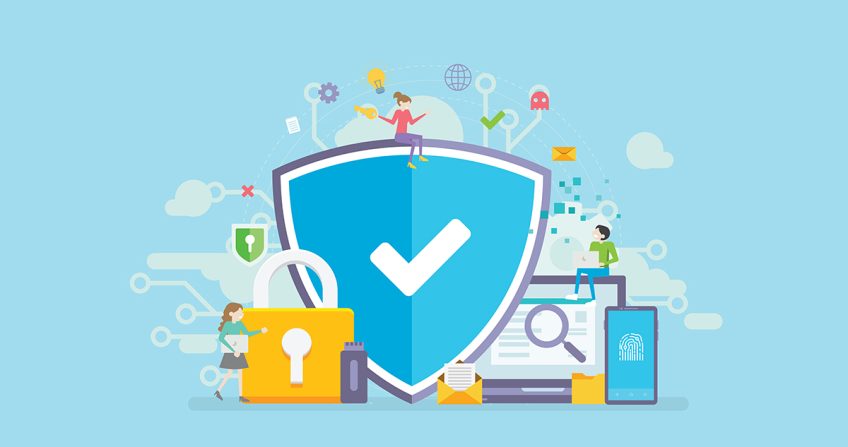The need to back up data has been a requirement since the invention of the computer. Data losses can occur for a variety of reasons, including hard drive and system crashes, security breaches and virus infections, and unfortunately most of us have experienced a loss of data at least once.
Twenty percent of small and medium-sized businesses will suffer from a data loss every five years, and it is these ongoing losses that have led to a cloud backup market that continues to grow exponentially.
One element of data backups that is increasing is the need for added security measures to be in place. Simply backing up your data is not enough anymore, your data procedures should now include data protection as well.
What does this new advice mean?
It means that your backup processes require more security consideration and protection, as while the new cloud-based backups are convenient, they face constant threats from online attacks and breaches.
Businesses need to consider data protection when implementing their backup and recovery strategies, and the tools that they might need to use to protect themselves against a growing number of online threats.
Some of the threats to data backups include:
- A data centre outage: Data held in the cloud is also held on a server, and these servers can crash. The data centres responsible for these servers can also suffer from outages.
- Misconfigurations: Misconfiguration of security settings can be problematic as they can allow attackers to gain access to data stored on the cloud, after which they can alter, download, and delete files.
- Sleeper ransomware: This type of threat remains silent after infecting a device, and its goal can be to infect all backups. If activated it can be devastating, as the victim will not have an unaffected backup point to restore to.
- Supply chain attacks: This type of attack has been growing recently, and it includes attacks on cloud vendors that businesses utilise. During the attack, vendors suffer a breach which can then spread to their clients.
Data Protection And Backups: What To Look Out For And What You Can Do
Scheduling backups of your data is not enough, you need to make sure that the backup application that you use also provides adequate data protection. Here are some things to look for and some measures that you can implement to enhance your data backups and protection:
Ransomware Prevention
Ransomware spreads throughout a network and infects data. This includes data stored on computers, mobile devices, and servers, and it could also include data that is syncing with cloud-based platforms.
According to one report, 95% of ransomware attacks also attempted to infect data backup storage, therefore it is important that any data backup solution that you use features protection from ransomware attacks, and other nefarious actions.
Constant Data Protection
Constant data protection is a feature that you can use that backs up files as changes are made, which differs from the practice of a scheduled backup, such as once per day.
Constant data protection ensures that your system records the latest file versions, and this will help mitigate loss if a system crashes before its next scheduled backup, which would save time and ultimately cost less.
Identification Of Threats
Proper data protection includes the identification of threats, and you should incorporate threat identification tools to your backup procedures. This type of tool is used to help prevent malware and virus infections and looks for threats in new and existing backups.
Employ A Zero-Trust Approach
A zero-trust strategy advocates for all users and apps to require continual authorised authentication in order to access a system. This can include measures such as multi-factor authentication (MFA) and application white and safe listing.
Some zero-trust features include:
- Contextual authentication
- Distinct file and folder permissions
- Multi-factor authentication (MFA)
- Verification of permissions for file changes
Backup Mirroring
Backup procedures should have a mirroring process in place, where any server holding your data mirrors that data to another server. This will help prevent data loss if a server crashes, or if a business suffers from a cyberattack or even a natural disaster.
Air Gapping
Air gapping is another method that can be used to keep a copy of your data offline or separated from your primary server or storage. This entails making a backup copy of your data and then placing it in another external storage location.
This process is often used in high-security scenarios that deal with sensitive data, as it helps to ensure that at least one copy of your data is separated from cybersecurity threats.
Shared Responsibility
Shared responsibility is a concept where you and your cloud vendor take shared ownership and responsibility for the access and protection of your data, including in the cloud.
Many cloud providers, such as Microsoft, are not responsible for the client data that they store, and therefore the onus for the storage and protection of the clients’ data is on the client themselves. Smaller storage providers may be more willing to work with you on this, and it is worth investigating.
Schedule A Data Protection Day, Week Or Month
Taking place on January 28 each year, Data Protection Day aims to promote awareness of data protection and data privacy. While this awareness should be constant, dedicated one-off events can help raise the overall awareness of data protection among staff and the community, and they are worth considering and implementing in the workplace.
Do You Need Help With Your Data Backups And Data Protection?
Backing up your data and its security and protection is a very important aspect of any business’s functions. Aryon are specialists in this field, and we can ensure that your data and information are backed up safely and securely on a regular basis. Please contact us today to learn more.








